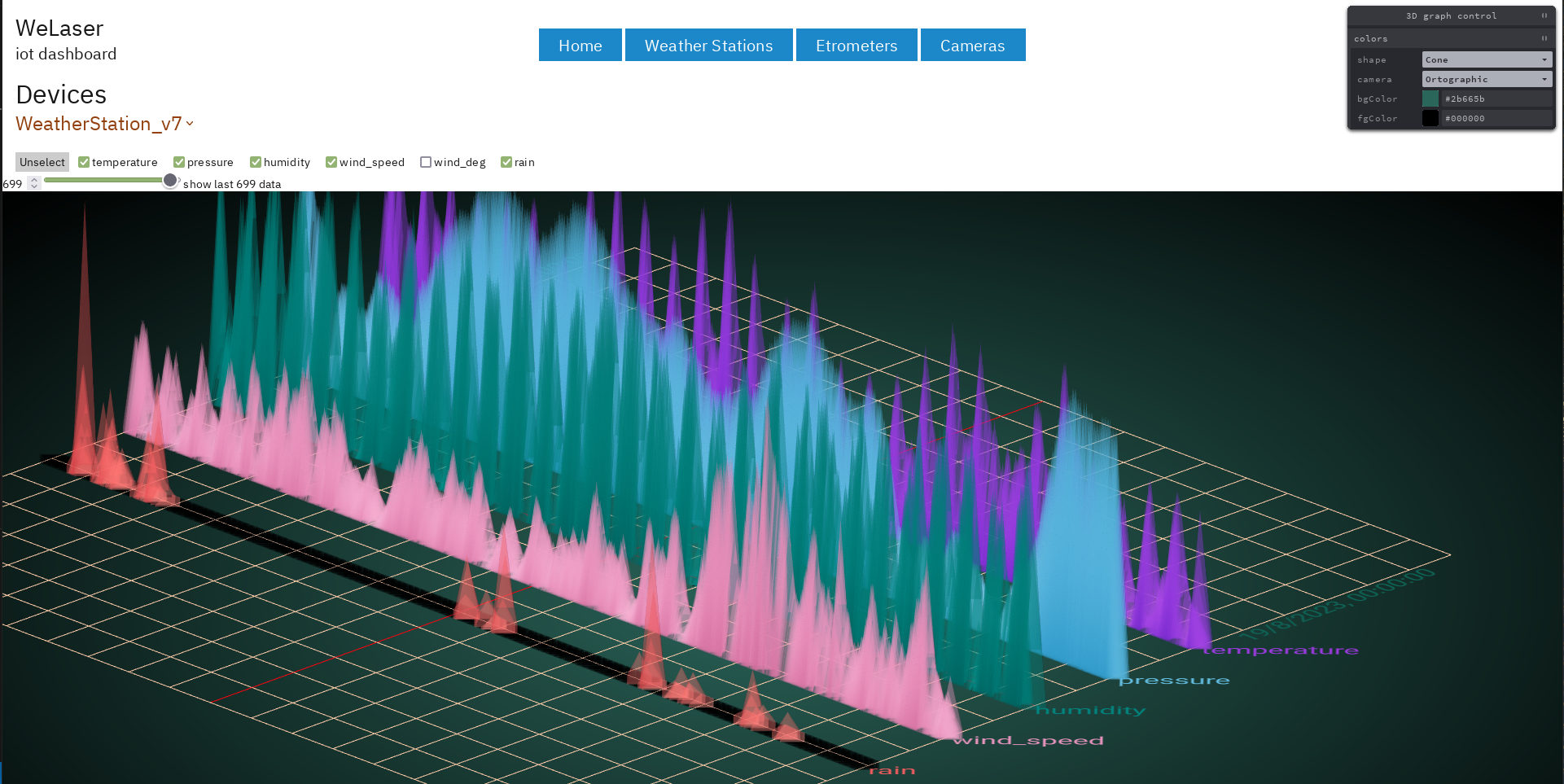Iotbroker is part of the server infrastructure for the WeLaser project,
The data acquisition and brokering is made out of several python programs present in the project's root
The data visualization/web is made in Svelte/Sveltekit and is in svelte-dash/
graph TD
a{{field & robot images}} --- A
A[robot_img.py] -- Ardesia --> B((FTP))
A -- Ardesia --> C((MQTT))
B --> D[image_logger.py]
C --> D
D -- Cesena --> E((FTPS))
D -- Cesena --> F((MQTTS))
G[weather_logger.py] --> F
g{{sensors}} --- F
F --> H[mqtt_logger.py]
H --> I[websocket_async.py]
I --> L((WEB))
H --> M[message_parser.py]
M --> N[(DB)]
As shown in the image, the cameras in the fields and in the robots sends images to Ardesia FTP and MQTT server.
image_logger.py is responsible to log the MQTT messages and resend the images/messages to Cesena FTP's and MQTTS's server.
Also other devices, like the weather stations, send messages to Cesena MQTTS's server.
Listening to all the messages is mqtt_logger.pythat sends websocket event to the web interface (via websocket_async.py) and updates the db with message_parser.py that is also used to seed the db by the json in data/
message_parser.py reads json MQTT messages and translate it to a Prisma db query.
image_logger.py, mqtt_logger.py and weather_logger.py inherits from the base class AsyncMqttClient from mqtt_async.pythat use a custom async_paho_mqtt_client
test_welaser.py is interactive and used to test the different functionalities
image_logger.py creates www/images.json to help Svelte show the new camera images without having to rebuild the website.
Prisma javascript client is used for all the web realated queries.
@carbon/charts is used for 2D charts and threlte for 3D charts
Public facing API are available from the /api routes, easing the integration of other web app:
-
GET all the messages for a given device as json
${base}/api/messages/${device_type}i.e./api/messages/weatherstation_sit optionally accept a start and end date i.e./api/messages/weatherstation_s?start=2023-10-30T13:55:30.000Z&end=2023-10-30T23:55:30.000Z -
To GET the CSV for the selected device
${base}/api/csv/${device_type}/${device_selected}i.e./api/csv/weatherstation_v/WeatherStation_v0 -
By using POST to get the CSV it's possible to select also the categories and start/end date
category_on = ["temperature", "wind"]
const start = new Date();
start.setDate(start.getDate() - 5); // 5 days before now
const range = [start, new Date()]
csv_p = await post_CSV(range, device_type, device_selected, category_on )
async function post_CSV(range, device_type, device_selected, category_on ) {
const url = `/iot/api/csv/${device_selected}`
const response = await fetch(url, {
method: 'POST',
body: JSON.stringify({
'device_type': device_type,
'category_on': category_on,
'range':range,
}),
headers: {
'Content-Type': 'application/json; charset=UTF-8'
}
});
const text = await response.text()
if (response.ok) {
return text
} else {
throw new Error(text)
}
}-
carbon chart's data are with GET request
${base}/api/${device_type}/${device_selected}${params}where params are the start and end date i.e./api/weatherstation_n/WeatherStation_n1?start=2023-09-16T13:12:43.108Z&end=2023-09-25T07:00:00.000Z -
Likewise for carbon chart's options i.e.
/api/options/weatherstation_n/WeatherStation_n1?start=2023-09-16T13:12:43.108Z&end=2023-09-25T07:00:00.000Z shared.ts:34:9 -
To GET the list of the devices for a certain device_type
${base}/api/devices/${device_type}like/api/devices/weatherstation_v -
To GET the timestamp ranges for a certain device
${base}/api/range/${device_selected}like/api/range/WeatherStation_n1this will return an array with[firstDate, viewDate, lastDate]with the firstDate being the first available record, viewDate being the selected start date, and lastDate the selected end date, defaults to last records.
Install python preferebly with pyenv. pyenv allows you to quickly install and use different versions of python via the command line.
for example: curl https://pyenv.run | bash and pyenv install 3.11.4
Install node preferably with nvm. nvm allows you to quickly install and use different versions of node via the command line. for example:
curl -o- https://raw.githubusercontent.com/nvm-sh/nvm/v0.39.7/install.sh | bash
and nvm install v18.19.0
Optionally, install pnpm curl -fsSL https://get.pnpm.io/install.sh | sh -
Install postgres sudo apt install postgresql
sudo -u postgres psql template1 and set your db password
ALTER USER postgres with encrypted password 'your_password';
Run pip install -r requirements.txt for python
then cd ./svelte-dash and pnpm i for node packages
Be sure to have the right .env file with the credentials both in the root folder and in svelte-dash/
Recreate the /www static asset with the symbolic link/or directory pointing to your server static asset.
Configure the DATABASE_URL accordingly.
For example if use SQLlite DATABASE_URL="file:../../data/iot_dev.db?connection_limit=1" If you don't use SQLlite you can skip the ?connection_limit=1 part but set the right db in svelte-dash/prisma/schema.prisma.
For postgres DATABASE_URL="postgresql://postgres:your_password@localhost:5432/iotgreenlab?schema=public"
For the async python client uncomment the relevant section at the top of /svelte-dash/prisma/schema.prisma then generate it with python3 -m prisma generate in the active environment and within the svelte-dash/ directory
For the async javascript client, uncomment the relevant section at the top of /svelte-dash/prisma/schema.prisma then generate it with npx run generate within the svelte-dash/ directory
Create the db with npx prisma db push
Seed the db (if not using the example's SQLlite dev db)
For the python server: within the active enviroment at the root of the cloned repo, run python mqtt_logger.py this will listen to the MQTT server, spawn a websocket server and parse the incomming data inserting them into the DB
For the web server: within the svelte-dash/ directory run npm run dev for the development version. To build run npx run build and to preview the build npx run preview
To change the schema make the changes in svelte-dash/prisma/schema.prisma.
migrate with: npx prisma migrate dev --name 1_add_ws where 1_add_ws is the name of the migration



